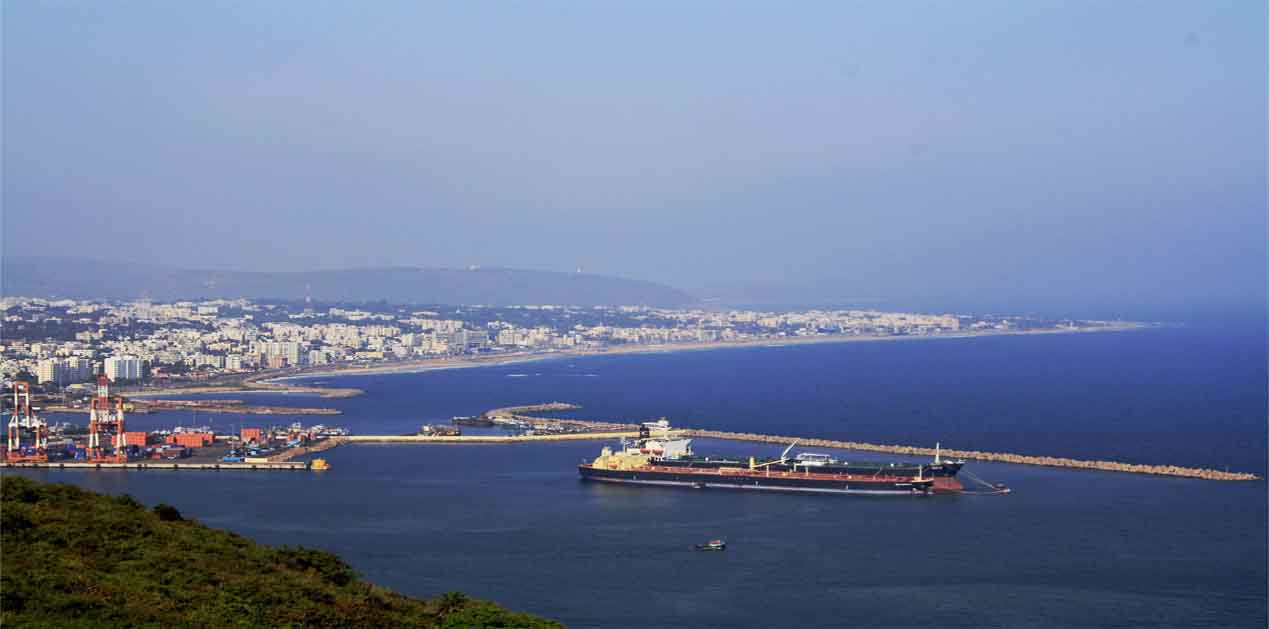As part of Indian Prime Minister Narendra Modi’s neighbourhood connectivity policy, India allowed Nepal to use Visakhapatnam Port of Andhra Pradesh in 2016 for trade with third countries. It was for a long time that Nepal had been making a demand for the use of this Port as an alternative to Kolkata/Haldia Port in India.
During the workshop on “Nepal-India Trade, Transit and Connectivity: Issues and Facilitations” organized jointly by the Nepali Embassy in India and Delhi-based Institute for Defence Studies and Analyses (IDSA) in Visakhapatnam on July 12, 2017, the author had an occasion to visit various sites of Visakhapatnam Port and get firsthand information on its operational aspects. Information gathered from the Port authorities and through interactions with workshop participants revealed that the use of the Port for Nepal’s trade with third countries was most beneficial to the country.
The distance between Kolkata Port (India) and Birgunj (Nepal) is 706 km; while the distance between Haldia Port and Birgunj is 818 km. Dhamra Port Company Limited (DPCL), which is a private port, is 941 km from Birgunj and the Visakhapatnam Port is 1,439 km from there. With the increase in the distance, the freight cost between Birgunj and different ports in India also increases. For example, the base freight of coal traffic between Kolkata Port and Birgunj is INR 1,093, which is INR 1,208 for Haldia, INR 1,400 for Dhamra and INR 2,003 for Visakhapatnam. Obviously, the Kolkata port has a geographical advantage over all other Indian ports because of its nearness with the Nepalese territory. The distance between Birgunj and Kolkata Port is almost half of the distance between Birgunj and Visakhapatnam Port. Accordingly, the freight charge between Birgunj and Kolkata Port is also nearly half as compared to the same with Visakhapatnam Port. Yet, the net gain to the business community is far more from Visakhapatnam Port as compared to the Kolkata Port. With 16.5 meters deep water, the Visakhapatnam Port is deepest one in India. Four ships of small size or three ships of larger size could discharge and upload goods at this Port simultaneously.
Because of its nearness with Malacca Strait, the transportation cost is less at Visakhapatnam Port as compared to Kolkata Port. It also offers direct connectivity to China, South East Asia and the Middle East. Moreover, the transportation of goods between Visakhapatnam and Birgunj is Cost Insurance Freight (CIF), but this facility is not available with Kolkata Port. Presently, the Visakhapatnam Port is operating below its capacity. Unlike the Kolkata/Haldia Port that is over utilized, only 60 per cent of Visakhapatnam’s capacity has been utilized. Additionally, the services at Visakhapatnam Port are so efficient that imports are discharged and exports loaded in the shortest possible time. Therefore, there is no room for demurrage charge and other undocumented expenditures in transporting goods through the Visakhapatnam Port, which is quite common at Kolkata Port. Equipped with latest technology, the Visakhapatnam port offers advanced logistic services of global standards for 24x7 days. It is fully automated and most modern in South Asia where manual interventions are least. Almost all the customs formalities at Visakhapatnam port are performed through computers. As such, the transactions are paperless and fast. Each activity is transparent there. It provides end to end solution from the port to destination and also from source to destination. Because of its linkages with the internet, the importer and exporter might track the location of the containers from the point of “origin” to the “destination.” There are two railway sidings with full rake handling facility at Visakhapatnam terminal. It has a dequate arrangement for refrigeration of goods. From the next year on March 2018, it is likely to introduce X-ray plant to identify the goods carried by the containers.
Service between Birgunj and Visakhapatnam Port has already resumed. The first train with containers from Visakhapatnam Port reached Birgunj last June and now the second train is likely to follow. It takes five days for the railway containers to reach Birgunj from Visakhapatnam. On the contrary, it normally takes 10 days for the containers to reach Birgunj from Kolkata, though the distance between the two places is almost half of Birgunj and Visakhapatnam. Because of the railway links between Visakhapatnam Port and Birgunj, Nepal could import dry fruits from Andhra Pradesh in India far cheaper than what is available in the local market here today. Also, the Visakhapatnam Port is the hub for fish and seafood, which could also be imported into Nepal cheaper. Additionally, a great opportunity waits for Nepal to do business in South India, which is until today unexplored land. The containers returning from Birgunj to Visakhapatnam Port could be used for exporting goods produced in Nepal. Thus, Nepal could export to the South Indian states, including Andhra Pradesh, all such items as spring water, herbs, Pashmina and various agricultural and industrial goods at minimal transportation cost.
There is no need for transhipment of goods in Singapore for the vessels that are destined to Visakhapatnam Port because of its deep water. But the vessels have to be transshipped in Singapore if they are destined to Kolkata Port as it is not so deep. The cost of transportation of goods is higher through Kolkata Port because of transhipment of goods in Singapore and also due to a lesser volume of vessels. Today, the Visakhapatnam Port handles vessels carrying up to 7,000 containers, but it could handle vessels of still larger sizes like with 10,000 containers. Normally, the cost of transportation per container is the US $ 700 to 800 through Visakhapatnam Port; whereas it is as high as the US $ 12,000 per container if it comes through Singapore.
The Visakhapatnam Port is far more cost effective to Nepal than any other port of China for trade with third countries. Tianjin port, which is closer to Beijing and at the distance of 5,000 km from Nepal, is made available to Nepal for trade with third countries as per Transit Transport Agreement with China in March 2016. But it cannot compete with Visakhapatnam port in terms of cost-effectiveness. The fact is that Nepal has not been able to use the Chinese port so far. Use of Visakhapatnam port has just begun on an experimental basis. However, the prospect of the use of Chinese port seems to be a remote possibility as it is politically motivated rather than commercially viable. The longer distance of the Chinese port from Nepal and also the higher altitude through which it would have to pass in China is its greatest disadvantage.
Today 98 percent of Nepal’s imports and exports with third countries take place through Kolkata Port, which could be substantially reduced if the Visakhapatnam Port is widely used. Considering that four-lane Bridge is likely to be constructed at Mahakali River, the country could find it more convenient in future to have trade with Gulf and Western countries from its western region through India’s western sea ports in Gujarat rather than through the Kolkata or even Visakhapatnam Port. Nevertheless, the Visakhapatnam Port at the present time appears to be more advantageous to Nepal for trade with third countries than the Kolkata Port considering the time and overall freight cost factors. Any diversion of goods from Kolkata port to Visakhapatnam port on Nepal’s trade with third countries will also compel the Kolkata port authorities to improve their services and be competitive. In view of the generous attitude of India towards Nepal’s development, the country could now ask India to allow it to use not only the Kolkata/Haldia and Visakhapatnam Ports for trade with third countries, but also to use any Indian port that could be of use to it. Such cooperation between the two countries could take our friendly relations to a still greater height and provide Nepal unlimited scope to change itself from ‘landlocked’ to ‘land-linked’ and further to ‘sea-linked’ country.
Jha is Executive Director of Centre for Economic and Technical Studies in Nepal
Image Source: https://www.bizbilla.com/hotnews/fintech-valley-to-be-set-up-in-visakhapatnam-5023.html











Post new comment